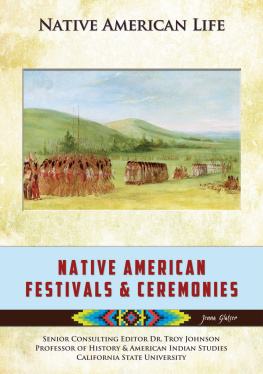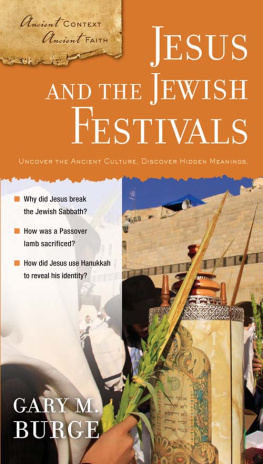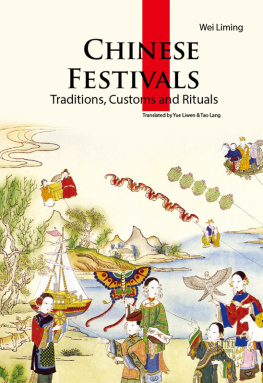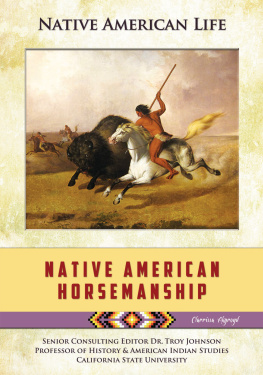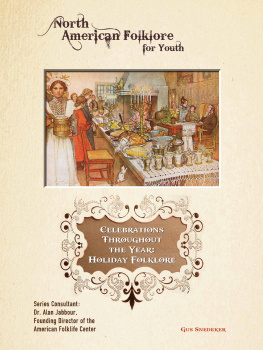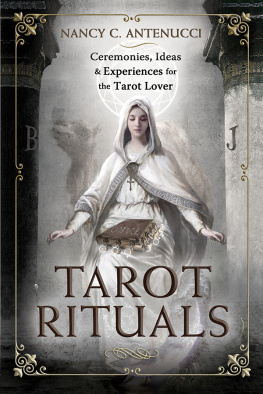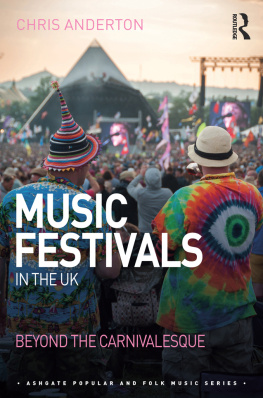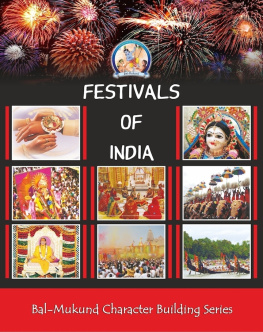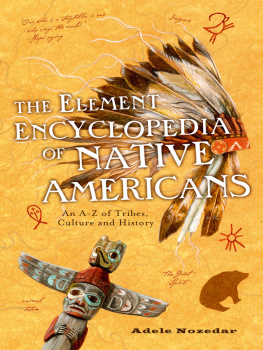NATIVE AMERICAN FESTIVALS AND CEREMONIES
Jenna Glatzer

NATIVE AMERICAN LIFE
E UROPEANS AND N ATIVE A MERICANS
H OMES OF THE N ATIVE A MERICANS
H UNTING WITH THE N ATIVE A MERICANS
N ATIVE A MERICAN C ONFEDERACIES
N ATIVE A MERICAN C OOKING
N ATIVE A MERICAN F AMILY L IFE
N ATIVE A MERICAN F ESTIVALS AND C EREMONIES
N ATIVE A MERICAN H ORSEMANSHIP
N ATIVE A MERICAN L ANGUAGES
N ATIVE A MERICAN M EDICINE
N ATIVE A MERICAN R ELIGIONS
N ATIVE A MERICAN R IVALRIES
N ATIVE A MERICAN S PORTS AND G AMES
N ATIVE A MERICAN T OOLS AND W EAPONS
W HAT THE N ATIVE A MERICANS W ORE
NATIVE AMERICAN FESTIVALS AND CEREMONIES
Jenna Glatzer

SENIOR CONSULTING EDITOR DR. TROY JOHNSON PROFESSOR OF HISTORY AND AMERICAN INDIAN STUDIES CALIFORNIA STATE UNIVERSITY

This book is dedicated to Paul Glatzer (the best brother in the world) and Marie Chieffo, because she never forgets a promise!
 | Mason Crest
450 Parkway Drive, Suite D
Broomall, PA 19008
www.masoncrest.com |
2014 by Mason Crest, an imprint of National Highlights, Inc.
All rights reserved. No part of this publication may be reproduced or transmitted in any form or by any means, electronic or mechanical, including photocopying, recording, taping, or any information storage and retrieval system, without permission from the publisher.
Printed and bound in the United States of America.
CPSIA Compliance Information: Batch #NAR2013. For further information,
contact Mason Crest at 1-866-MCP-Book
First printing
1 3 5 7 9 8 6 4 2
Library of Congress Cataloging-in-Publication Data
Glatzer, Jenna.
Native American festivals and ceremonies / Jenna Glatzer.
pages cm. (Native American life)
Includes bibliographical references and index.
ISBN 978-1-4222-2970-5 (hc)
ISBN 978-1-4222-8857-3 (ebook)
1. Indians of North AmericaRites and ceremoniesJuvenile literature. I. Title.
E98.R53G53 2013
970.00497dc23
2013007469
Native American Life series ISBN: 978-1-4222-2963-7
TABLE OF CONTENTS
For hundreds of years the dominant image of the Native American has been that of a stoic warrior, often wearing a full-length eagle feather headdress, riding a horse in pursuit of the buffalo, or perhaps surrounding some unfortunate wagon train filled with innocent west-bound American settlers. Unfortunately there has been little written or made available to the general public to dispel this erroneous generalization. This misrepresentation has resulted in an image of native people that has been translated into books, movies, and television programs that have done little to look deeply into the native worldview, cosmology, and daily life. Not until the 1990 movie Dances with Wolves were native people portrayed as having a human persona. For the first time, native people could express humor, sorrow, love, hate, peace, and warfare. For the first time native people could express themselves in words other than ugh or Yes, Kemo Sabe. This series has been written to provide a more accurate and encompassing journey into the world of the Native Americans.
When studying the native world of the Americas, it is extremely important to understand that there are few universals that apply across tribal boundaries. With over 500 nations and 300 language groups the worlds of the Native Americans were diverse. The traditions of one group may or may not have been shared by neighboring groups. Sports, games, dance, subsistence patterns, clothing, and religion differedgreatly in some instances. And although nearly all native groups observed festivals and ceremonies necessary to insure the renewal of their worlds, these too varied greatly.
Of equal importance to the breaking down of old myopic and stereotypic images is that the authors in this series credit Native Americans with a sense of agency. Contrary to the views held by the Europeans who came to North and South America and established the United States, Canada, Mexico, and other nations, some Native American tribes had sophisticated political and governing structuresthat of the member nations of the Iroquois League, for example. Europeans at first denied that native people had religions but rather worshiped the devil, and demanded that Native Americans abandon their religions for the Christian worldview. The readers of this series will learn that native people had well-established religions, led by both men and women, long before the European invasion began in the 16th and 17th centuries.
Gender roles also come under scrutiny in this series. European settlers in the northeastern area of the present-day United States found it appalling that native women were treated as drudges and forced to do the mens work in the agricultural fields. They failed to understand, as the reader will see, that among this group the women owned the fields and scheduled the harvests. Europeans also failed to understand that Iroquois men were diplomats and controlled over one million square miles of fur-trapping area. While Iroquois men sat at the governing council, Iroquois clan matrons caucused with tribal members and told the men how to vote.
These are small examples of the material contained in this important series. The reader is encouraged to use the extended bibliographies provided with each book to expand his or her area of specific interest.
Dr. Troy Johnson
Professor of History and American Indian Studies
California State University

The native inhabitants of North and South America often danced at their ceremonies and festivals. The dances had different purposes, such as giving the dancers strength for a hunt or protection during battle.
Native Americans had many different kinds of festivals and ceremonies to honor different events, seasons, people, places, and elements of nature. Today, many of these celebrations still exist in Native American communities. Some have been lost over the years, but we can learn a lot about Native American peoples by studying these traditions: what was important to the people and what they hoped, believed, feared, and prayed for.
Festivals and ceremonies were held for different reasons. Usually, an event was meant to give thanks for good things (like successful hunts and harvests), to mark an important change in someones life (like when boys and girls began adulthood), or to communicate with the spirits (asking them to bring rain or heal sick people, for instance). A ceremony was a holy, spiritual event, while a festival was less formal and more social. There were some sacred ceremonies only for women or only for men.
These festivals and ceremonies were colorful and exciting. Different tribes had different kinds of occasions, but they all shared things in common. For example, participants wore fancy clothing, often sang, danced, and played instruments, feasted on wonderful meals, held contests, smoked tobacco, and gave gifts. Keeping traditions alive was important to the Native Americans. Thus, there were certain rules the Native Americans followed, depending on the type of event. These rules were passed down from parents to children and family to family so they could remember the ways to celebrate, give thanks, remember the dead, and communicate with spirits.
Next page
